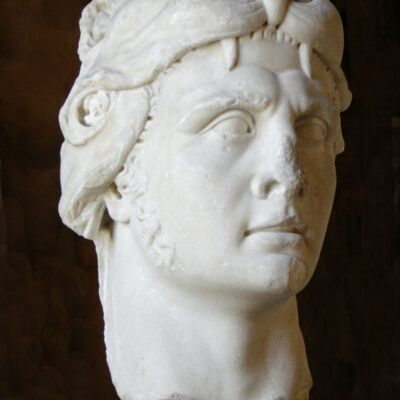Chapters
Battle of Chaeronea and Orchomenos (86 BCE) were another clashes in Greece, in which Roman troops defeated the Pontic army and stopped the expansion of the growing, ambitious Mithridates VI.
Historical background
The first half of the 1st century BCE was a time of intense struggle for Rome, which additionally had to deal with internal problems. The growing wealth of the political elite and the pauperization of the Italian population led to bloody clashes between parties centred around eminent leaders. Worse still, Rome’s Italic allies rebelled against the Senate, demanding political equality. This situation was used by the Republic’s neighbours to act boldly on its borders. One of the most dangerous challenges the Sons of Wolf faced appeared in the East, where the ruler of Pontus, Mithridates, decided to follow in the footsteps of Alexander the Great and significantly expand the boundaries of his kingdom.
After his accession to the throne in 113 BCE, Mithridates implemented a policy of subjugating neighbouring peoples, strengthening his military and political power in the region. After the victories over the Scythians and the conquest of the northern shores of the Black Sea, the ambitious ruler turned his gaze to the vast territories of Asia Minor, belonging directly to the Romans or creating their sphere of influence – Asia, Paphlagonia, Bithynia and Cappadocia. In 108 Mithridates made a pact with the King of Bithynia, Nicomedes, sharing the lands of Paphlagonia with him. The Romans were too preoccupied with the fighting in Africa and repelling the German invasions in the north to react firmly to these events. The Pontic also occupied Cappadocia, but at the request of Rome, Mithridates and Nicomedes withdrew from the newly conquered territories. The Governor of Cilicia Lucius Cornelius Sulla placed Ariobarzanes on the throne of Cappadocia, but this did not help to quell the already smoldering conflict. Mithridates persuaded his son-in-law Tigranes to attack this province, and he himself invaded Bithynia. This time, the Senate sent an army of several thousand under the command of Manius Aquilius, who persuaded Nicomedes to engage in hostilities against Mithridates. The ruler of Pontus, somehow anticipating the actions of his enemies, went to Cappadocia, which was the reason for the outbreak of the conflict, called by historians the First War with Mithridates (88-85 BCE).
The conflict was started by Mithridates by attacking Bithynia, whose troops were defeated in the fight against the invaders. In several clashes, the Pontic armies defeated or rejected the Roman armies, conquering all of Asia Minor. Mithridates tried to win over the local Greeks, presenting his action as liberating them from Roman captivity. The great Pontic army under the command of Archelaos entered the European continent in 88 CE, gaining the support of some of the inhabitants of Athens and southern Greece. Internal fighting in Rome delayed Rome’s response to these events again, and it was only in CE 87 that Sulla’s army of 5 legions entered the area of hostilities in Greece. His troops besieged Athens, which succumbed to the legionaries only after a long siege and starvation of the defenders. Archelaus, driven out of Piraeus, joined forces with the second Pontic army, which followed the route from Thrace through Macedonia to Greece. In response to this move, Sulla directed his army to Boeotia, where he took up positions on a hill next to an important communication route, prepared for the enemy’s arrival.
Battle of Chaeronea (86 BCE)
The Roman forces numbered over 30,000 legionaries supported by 5,000 Greek infantry and 2,000 cavalry. The Pontic forces consisted of 30,000 infantry, 20,000 Asian light troops, 15,000 phalanxes, 2,000 cavalry, and 250-500 menacing but obsolete combat chariots. Ironically, there were few Greeks in the ranks of Pontus’ army who lost all hope of defeating Rome after the fall of Athens. Both armies were separated by the River Kefisos. Fearing cutting off their own communication lines, the Roman commander and the entire army blocked the communication route running along the hill. When Archelaos wanted to march the nearby city of Chaeronea, Sulla blocked the manoeuvre again. The two armies now faced each other. Sulla has excellently explored the area of future struggles. Seeing his opponent camped on uneven terrain, surrounded by steep rocks, he decided to immediately occupy the adjacent plain. Such a position of the Romans allowed them to freely pursue the enemy and vice versa, while the army of Archelaos was deprived of these possibilities. Sulla positioned the legions into a phalanx and placed a cavalry on the wings. He himself took command of the right-wing, the left one based on the Kefisos River and handed over to Murena on Thurium Hill. The legates of Sulla, Hortensius and Galba took the rear on the hills with the task of protecting the entire front from encirclement. In addition, the Roman commander surrounded the sides and rear of his troops with a ditch. Despite the outnumbering of the Pontic troops, their commander, Archelaus, was poorly qualified as a strategist. The left Roman wing became a critical point of the fighting, on which at the beginning of the battle a larger group of Archelaos’ army moved. However, the Roman troops occupying the hill repelled the enemy attack, which lost many people in this clash. In downtown, Archelaos has thrown combat vehicles into battle. However, they did not fulfil their role, as the too small distance from the Roman ranks made it impossible to take greater momentum during the attack. The Roman legionaries passed the chariots through their ranks and then slaughtered their crews in the rear. When the infantry forces clashed in the centre, the Pontic phalanxes tried with their long spears to force the legionaries to retreat. These, fighting with short swords, tried to get to the opponents, smashing their lances. However, the first ranks of the Pontic, made up of royal slaves, fought bravely and did not quickly give way to the heavy legionary infantry. Meanwhile, repeated attacks by Archelaos’ army on the left Roman wing risked its destruction. Sulla, seeing this threat, sent reserve troops there from the centre. When the Pontic commander again sent fresh troops to strike this section, Sulla was forced to deploy all reserve (cavalry) forces at the site. Archelaus, seeing the right-wing of the Romans left without the protection of the reserves, directed a massive attack there. At this critical moment in the battle, Sulla started driving from the left wing to his right flank, which led to the defeat of Archelaos’ troops in this section. The left Pontic wing was surrounded and was destroyed. Then the Romans again supported the Murena wing, as a result of which the right Pontic wing was also destroyed. The total defeat of Archelaos’ army on the flanks forced the centre of his troops to retreat, which was hampered by the steep terrain. Only 10,000 warriors remained of the Pontic army of many thousand. Roman losses were only 15 killed, which seems to be an exaggerated number. According to some researchers, such understated data may not apply to the entire Roman army, but only to the indigenous Romans, who were a minority in Sulla’s army.
Battle of Orchomenos (86 BCE)
Despite the stunning success at Chaeronea, Sulla’s position in Greece was still precarious. At that time, Archelaos was joined by selected Pontic troops in the strength of 80,000 soldiers. King Pontus himself controlled the waters of the Aegean Sea. At the same time, a new Roman army arrived in Greece under the command of Consul Flaccus, who was to take the command of Sulla, deprived of power in Rome by political opponents. So Sulla took a convenient position in Melitene, ready to fight Flakkus and fight Archelaos at the same time. The latter, appreciating the military capabilities of his army, transported the troops by sea and landed in Boeotia. Upon hearing of this, Sulla moved towards him in order to fight a major battle, despite the fact that the opponent had at least a threefold advantage in numbers. The Pontic commander camped on the vast plain near Orchomenos near the marshes on the shores of Lake Copais. Opposite his position stood Sulla’s legions, lined up in three lines separated by paths in the event of chariot attacks. In front of the second line of legionaries, defensive barbed wire mesh was set up. Sulla also secured his army against the attack of the Pontic cavalry by building 10-meter-wide trenches on the sides of the front. As predicted by the Roman commander, Archelaos’ cavalry struck both flanks of his army. The attack on the left-wing of the Romans ended in failure. On the Roman right-wing, the Pontines almost succeeded, but Sulla himself launched the cohorts to counterattack and, with the help of troops from the left-wing, captured the rampart. Meanwhile, in the centre, Archelaos’ phalanx troops and war chariots attacked. Seeing their attack, the first legionaries retreated behind the barbed wire in front of the second legion line. When Pontus’ combat machines crashed into these fortifications, they were attacked by light-armed and Roman cavalry troops, which took advantage of the gaps in the enemy formation. The horses of the Pontic chariots panicked, causing confusion within their own ranks. Archelaos, seeing the critical situation of his troops in the centre, cancelled the cavalry attacking the Roman flanks in order to support the troops binding the enemy from the front. This was what Sulla was waiting for, throwing all his cavalry and legionary infantry to attack the disorganized enemy line. The Romans rejected the enemy and drove him as far as his camp. The losses of the Pontic army amounted to 15,000 men on the first day of fighting. Sulla now proceeded to surround the enemy camp in the ditch. Desperate, Archelaus tried to disturb the earthworks, but the unfortunate attacks on the legionaries digging the ditches did not prevent the Romans from taking over the camp. The escaping defenders together with the commander tried to protect themselves in the surrounding swamps. Most of their armies have been destroyed.
Importance of fights
After the pogrom of Mithridates’ forces, the number of his allies in Greece decreased significantly. The Hellenic cities, seeing Sulla’s triumph, lost all hope of defeating the all-powerful Republic. Moreover, rebellions broke out in Asia Minor against the reign of King Pontus. When another Roman army under Fimbria’s command dealt another defeat to the Pontic troops, Mithridates was forced to accept the terms of the truce. Also Sulla, absorbed in internal struggles with political opponents, was inclined to a ceasefire. As a result of the treaty ending the war, Rome regained its province of Asia. The King of Pontus was forced to pay 3,000 contribution talents, lose 80 ships, and retire from previously captured provinces. Only the lands inherited from his father were left to him. However, these restrictions did not diminish his military strength, and Pont did not become a subordinate “friend” of Rome. It was therefore a compromise that left open the question of further Pontic-Roman relations. The cessation of fighting did not prevent the resumption of hostilities at all and was only a break in the fight between both sides.
The general battles fought by Sulla were a testimony to the multi-tasking nature of Rome’s elite and the strength of the Empire, unstoppable by the civil war. Despite bloody internal fights in Italy and Rome in the first half of the first century BCE, Roman notables did not give up their activity in foreign policy and were ready to devote significant financial and military resources to securing the interests of the Empire on its borders. Despite the concentration of some forces on fratricidal wars, the Romans were able to field a strong army ready to resolve conflicts in the Hellenistic East.










